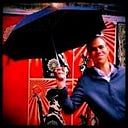When I was running festivals, we created an approach to join up the dots between activities we’d put forward in the cities — a creative challenge given the different social contexts & cultural interpretations of the issues!
What’s fascinating is how some of the cities put forward more activities than other others. A “bouillabaisse” approach where you pick all the freshest ideas from your city and mix them in together to reveal all the different flavours or a “bulli” approach that makes use different scientific and artistic techniques to condense down ideas into a unique aroma?
What types of activities?
We identified the following different types of activities and they each perform different roles.
1. Installations, living libraries & performances
…selected for how they create the spaces to challenge the way we’ve been brought up to think and act
- Installations on the use of the body as a form of physical resistance and as a new form of democratic participation
- Living Libraries with migrants and using our different senses to discover all the themes of the festival.
- Performances on how the body is used in political action, what we can learn from forum theatre to enact democracy and make sense of how migrants live to how can we use SMS to discuss brain drain.
2. Exhibitions, role plays and visualisations
…chosen for how they express the way we collectively feel about the issues we face and the wishes we dream about
- Exhibitions from cartoons to understand poverty and homelessness to understanding norms of social control of public spaces.
- Role Plays from simulating a people’s assembly to simulating the European parliament and role playing how migrants live their lives.
- Visualisations of how migrants feel crossing the borders and in detention camps to visualising how young people feel about being out of work.
3. Walks & workshops
…for enabling people to observe how neighbourhoods can provoke new thoughts and ideas on alternative futures
- Walks to discover how different cultures live in the city, through performances & games, as well as understanding the history of protest and economic alternatives and showing our discouragement and revolt at the crisis.
- Workshops to develop pop up democracy and civic activism using open space and creating outputs to social markets of alternatives to consumerism through alternative crafts and learning how to understand migrant’s experiences through making food and sharing stories.
4. Debates & film debates
…for how they enable people to share common experiences and issues between different cities
- Debates on everything from the influence of the Arab Spring, understanding social mobilisation, the invisible migrants in the city, the impact of migration on gentrification, to understand the impact of ideology on social mobilisation.
- Film Screenings to show what people they’ve lost when they move abroad, how we misunderstand culture, how Muslim communities feel inEurope and the Arab world to what we can learn from artistic mobilisation.
Three new memes pop out from this — the creative disruption of migration in social mobilisation, the role of the body in democratic participation, and negociating how to live together in the city. What is it that could link these concepts up?
